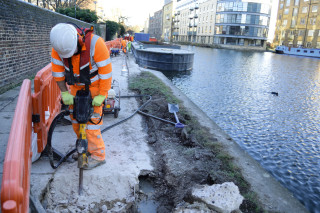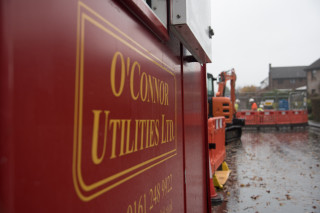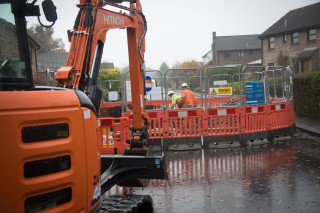The National Grid has started work on a project to remove or decommission a redundant network of high-voltage cables in Greater London. Most of the 44km network of 275kV oil-filled cables and associated plant is in an area stretching between Tottenham, St John’s Wood, Willesden and Wimbledon – one of the most densely-populated parts of the UK.
A lot of the work will take place in the vicinity of Network Rail critical network infrastructure and will involve excavations within heavily congested areas where other utility services – for water, gas and telecoms – are also located.
One of the most visible, and environmentally sensitive, parts of the project involves 8km of old cable following the Regents Canal towpath. The route passes major tourist attractions including London Zoo and runs right through Camden Lock market, London’s fourth most popular tourist destination, drawing 100,000 tourists every weekend.
The contractor tasked with the sensitive job of removing or decommissioning these cables is Manchester-based O’Connor Group (OCG). At a value of around £30m, the contract is a feather in the company’s cap and is purported to be the largest project of its type to have been awarded.
The key factor that won the work for OCG was its existing relationships with the stakeholders affected, such as the London boroughs, and its experience in managing similar projects where the main consideration is to cause as little disruption as possible.
As National Grid’s project lead Chris Shelton puts it: “With the support from O’Connor Group, we will work to minimise the impact of our essential works on the local community and environment.”
And OCG is well-placed to smooth the way for the project, as Mike McCloy, support services manager, is happy to point out.
“We’ve got close working relationships with all the stakeholders, from Network Rail to the Canal & River Trust, over the past 20 to 30 years and we could demonstrate that,” he says. “It’s not the engineering complexity that is the issue here but the urban location, though we hope to utilise this project to develop greater intelligence and new techniques.”
In fact, according to Shelton, the need to avoid disruption means that many cables will be left in situ.
“We can leave the cables that need decommissioning in the ground. This will avoid major disruption to the capital as we do not need to dig up long stretches of the road network,” he says. “Instead we will be removing the oil from the cables, which will have a positive impact on the local environment.”
But just because the cables are still in the ground they will not be forgotten as, once they have been flushed, OCG will install monitoring stations so that these redundant assets can be maintained proactively.
Site works for the project started in January and completion is due in June 2021. There are three separate elements: St John’s Wood to Tottenham; St John’s Wood to Willesden; and Willesden to Wimbledon.
In each case National Grid’s Electricity Transmission Operations team goes in first to carry out critical tasks such as removing cable and terminations within substation boundaries, cutting, capping and purging oil from the cables and removing oil containment equipment along the route.
Then the OCG team comes in to purge any oil left from the cables, remove any cable from land owned by third parties and then decommission all the equipment associated with the transmission circuit along the cable route.
The biggest challenge for the OCG team is the works along the towpath of the Regent’s Canal which, as well as passing through busy tourist spots, is also a popular amenity with walkers, runners, and cyclists as well as being home to houseboat owners.

It is also the area that needs some of the most urgent work. There are two buried 275kW cable circuits connecting two substations, St John’s Wood and Tottenham. Altogether the route is 16km long but 1.65km of this follows the canal towpath.
The cables here have failed repeatedly and are in such poor condition that oil has often leaked into the canal. Not surprisingly, National Grid is very keen to remove them. The towpath also carries 6.9km of 275kW cable linking the St John’s Wood substation to the Willesden one, and this also needs to be removed.
Here OCG’S relationships with stakeholders – and its diplomacy – will be tested as footpath closures and diversions will have to be agreed not only with the Canal & River Trust but also the residents of the various houseboats, who will need access to their homes. Another complication is that OCG needs to use barges to bring material and plant to the site and remove waste.
OCG’s proposal is therefore to suspend moorings and fence off approximately 400m of towpath at a time. It can then use a barge-mounted mini excavator to remove the concrete casing protecting the cables. The cables are laid in cement-bound sand which will be tested to see if it has been contaminated. If it is, the sand will be removed for disposal; if not, it will be reused.
As the cables become exposed, they will be placed on rollers and coiled into sections of up to 300m using a motorised cable drum mounted on the barge. Once the cable has been removed from the whole 400m section, OCG will then backfill the troughs that are left and reinstate the footpath before moving on to the next section.
And all this is to be done under the gaze of thousands of residents, commuters and tourists. There is a lot of scope for reputational damage, says McCloy, and yet he expects the project as a whole will be barely noticed by the general public.
“We feel that this project has been approached in the right way so that this work on the towpath should be the only visible part of a much larger exercise,” says McCloy. “We will access the cables for removal, flushing and purging in the residential areas and that is what we do day to day: liaising with residents and local authorities before carrying out the work.”
Why the cables need to be removed
From the 1930s until the invention of new cable materials such cross-linked polyethylene (XLPE), the accepted method of insulating high-voltage cable was to encase it in oil and then sheath it in lead.
These were installed throughout the transmission network, operating at 275kV and 400kV, and on the distribution network at 132kV down to 33kV. The most recent estimates reckon that there are 1,200km of oil-filled cables across the UK’s transmission network and a further 4,750km within the distribution network.
These cables have a design life of between 40 and 60 years so sooner or later they need to be decommissioned, removed or replaced.
The age of the cables, the fragility of the lead sheaths, the plumbed cable joints and the associated oil circuit are all of concern because, if the sheath is breached the oil will leak out, contaminating the surrounding soils and possibly the ground water.
The design of the oil-filled cable varies but essentially it consists of a layer of tightly-lapped cellulosic paper that has been impregnated with a low-viscosity dielectric oil. This layer boosts both the electrical and thermal insulation.
But not all oil-filled cables need to be de-commissioned. Before the introduction of XLPE cable the dielectric oil was replaced by a biodegradable cable fluid that poses little or no threat.
This article was first published in the February 2020 issue of The Construction Index magazine.
UK readers can have their own copy of the magazine, in real paper, posted through their letterbox each month by taking out an annual subscription for just £50 a year. Click for details.
Got a story? Email news@theconstructionindex.co.uk







